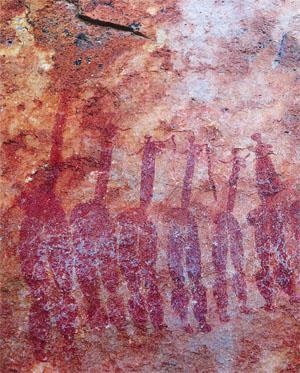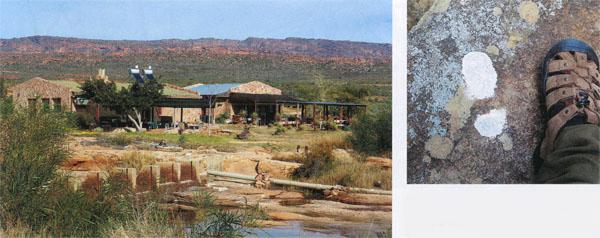Art of Stone
Words and pictures: Keri Harvey. Article from the October 2014 issue of Country Life Magazine.
Along the Brandewyn River in the Cederberg is a fascinating outdoor art gallery – a boulder-hopping trail past nine San rock art sites
It’s just an ordinary clump of bluegum trees next to the road. On an average day you’ll drive right past and hardly notice it. Unless you know what’s behind it.
Through an unobtrusive turnstile, and along the aptly named Brandewyn River that looks like a natural torrent of Klipdrift, is a superb outdoor art gallery, in the form of a hike. The self-guided Sevilla Rock Art Trail brings to life how these nimble hunter-gatherers experienced both this world and their world beyond.
 Rugged shoes, check. Hat, water and sunscreen, check. Guidebook, wouldn’t do without it. We’re through the white turnstile and set for five kilometres of rock hopping to peek into the simple but complex, and always spiritual, lives of the ancient San.
Rugged shoes, check. Hat, water and sunscreen, check. Guidebook, wouldn’t do without it. We’re through the white turnstile and set for five kilometres of rock hopping to peek into the simple but complex, and always spiritual, lives of the ancient San.
We follow the white-painted boot prints that indicate the trail across a worn rock ridge. A kilometre on, a tall rock fig clings to a sheer stone wall and flags the first site on the Sevilla Rock Art Trail. The painting here is most unusual, like nothing we’ve seen before. It’s of a large group of people, painted in black and seemingly superimposed on older images.
This practice of overlaying images is what presents problems with accurately dating San rock art. Caves were often ‘redecorated’ with new paintings over old, and there is also little material to be used for carbon dating – sometimes only charcoal or shells from the cave litter can date the site. Some rock paintings in the Western Cape are thought to be only about 400 years old because they depict European dress, horses and wagons; others, possibly much of the art, could be many thousands of years old. It’s believed the older paintings are finer, while the more recent paintings are bolder and coarser.
Up and down rocks we go, hardly as nimble as the San would have been – and sometimes with jelly legs – but determined to see their artistry and understand a little of their lives. Their paintings are all they left behind, with no written record of their history, but the visual story of their environment and beliefs contains astonishing detail.
First it was thought that San rock art simply recorded daily life; now it’s widely believed they also describe religious or spiritual practices, with some sites depicting hook-headed and cloaked figures with an animal head and two legs – therianthropes – showing how shamans start to feel like the animal as they enter trance. There are also paintings of bleeding noses and spirits entering the body while in trance. Precise interpretation remains controversial, though.
Just the previous day, we hiked to Bleeding Nose rock art site on neighbouring Bushmans Kloof Wilderness Reserve and clearly saw a figure with blood streaming from the nose. Guide Gerhard Thorn explained that the figures in trance crouched forward, held their stomachs, and their noses bled while they danced around the fire. Of course there were also plenty of eland on the rock walls, and it’s thought the San painted these to harness their energy, which they believed to be supernatural and good for healing the sick as well as for rain making.
 On Bushmans Kloof reserve, which has more than 130 rock art sites, we also visited Fallen Rock site with in excess of 400 different images. The art is dazzling, with numerous people – some cloaked – and elephants covering the rock face in various poses. There’s another bleeding-nose figure and possibly a shaman depicted with lines like extra limbs, as a spirit enters his body. This particular site is possibly up to 2 100 years old, dated from ochre and a tortoise shell found there.
On Bushmans Kloof reserve, which has more than 130 rock art sites, we also visited Fallen Rock site with in excess of 400 different images. The art is dazzling, with numerous people – some cloaked – and elephants covering the rock face in various poses. There’s another bleeding-nose figure and possibly a shaman depicted with lines like extra limbs, as a spirit enters his body. This particular site is possibly up to 2 100 years old, dated from ochre and a tortoise shell found there.
However, Gerhard explained that a red and yellow ochre was just one of the ‘paints’ used by the San. “The white colour fades first and was mostly limestone, and they used black pigment too, possibly from manganese oxide or charcoal. Blood, egg white, urine and plant sap were used to fix the colours. It worked very well because the paintings have lasted for centuries.” There’s no denying the San were master artists. Not just because of their durable paint, but for the way they expressed complex, conceptual and symbolic thoughts in their rock paintings.
Further along the Sevilla trail we are fascinated by strange dinosaur-like monsters painted at the second site, and at the third site we have to lie on our backs on the ground to see the paintings of headless animals on the underside of a low rock ledge. It’s possible the colours depicting the rest of the bodies were absorbed into the rock, or simply faded over time.
 Below us the river gushes by and we stop awhile in the shade before continuing to see newborn zebra foals, hunters in action, dancing ladies and handprints on cave walls. Randomly on the overhangs are ‘blobs’ of paint, originally thought to be mixing palettes; more recently believed to be ‘power or energy points’. Since the paint contained protein that was ‘alive’, the San believed that touching these power points gave them an extra energy boost.
Below us the river gushes by and we stop awhile in the shade before continuing to see newborn zebra foals, hunters in action, dancing ladies and handprints on cave walls. Randomly on the overhangs are ‘blobs’ of paint, originally thought to be mixing palettes; more recently believed to be ‘power or energy points’. Since the paint contained protein that was ‘alive’, the San believed that touching these power points gave them an extra energy boost.
Five kilometres is not far to walk, but rock hopping takes extra effort and hones our appetite for a robust lunch. The eland and pepperdew pizza is calling loudly as we retrace our footsteps and follow the boot prints over the rocks along the river bank. Back through the white turnstile at the now ‘remarkable’ gum trees, and on to the Khoisan Kitchen we go. If not eland pizza, there’s also eland pasta, pie, stew or burger – and it’s all delicious. This is, after all, the land of the San, so we willingly follow their ways.
As we drive slowly home through the Pakhuis Pass and on to Clanwilliam, we are entranced. The artwork is incredible; that it’s so old and enduring makes it even more so. That it’s painted with such simple tools makes it unique.
Blood, egg white, urine and plant sap were used to fix the colours. It worked very well because the paintings have lasted for centuries
From the painted walls we know wildlife here was prolific and diverse – and there were elephants too. More recently they saw ox wagons, men on horses and sailing ships, as depicted at other sites.
In trance they saw other worlds. They became the creatures they envisioned while in altered states. And we know this without the San writing a single word. It’s all in the pictures they painted, which tell us of their lives in full colour.
Handy Info
• Traveller’s Rest has 25 privately situated, self-catering cottages. 027 482 1824
• If you’re looking for luxury, not far away is the lodge at Bushmans Kloof Wilderness Reserve and Wellness Retreat. 021 437 9278, Email Website
• Check in and obtain your permit for the Sevilla trail at the Traveller’s Rest Farm Stall.
• Enjoy delicious venison and other delights at the Khoisan Kitchen at Traveller’s Rest Farm Stall, which overlooks the Brandewyn River.
• The best time to visit this area is autumn or spring when the weather is mild.
• To get to Traveller’s Rest, turn off the N7 to Clanwilliam. Stay on this road (the R364 to Calvinia) over the Pakhuis Pass, for another 34km.
| More info on the Cederberg Region |
Book your accommodation right here on ShowMe.
You can find the top hotels, lodges and Airbnb establishments conveniently placed on the map below. All you need to do is click on the place that’s conveniently located and within your budget and then make a booking. What could be easier?
If the map is not where you want to be, click on the ShowMe Pin and then enter the exact name of the location and the map will adjust accordingly.










